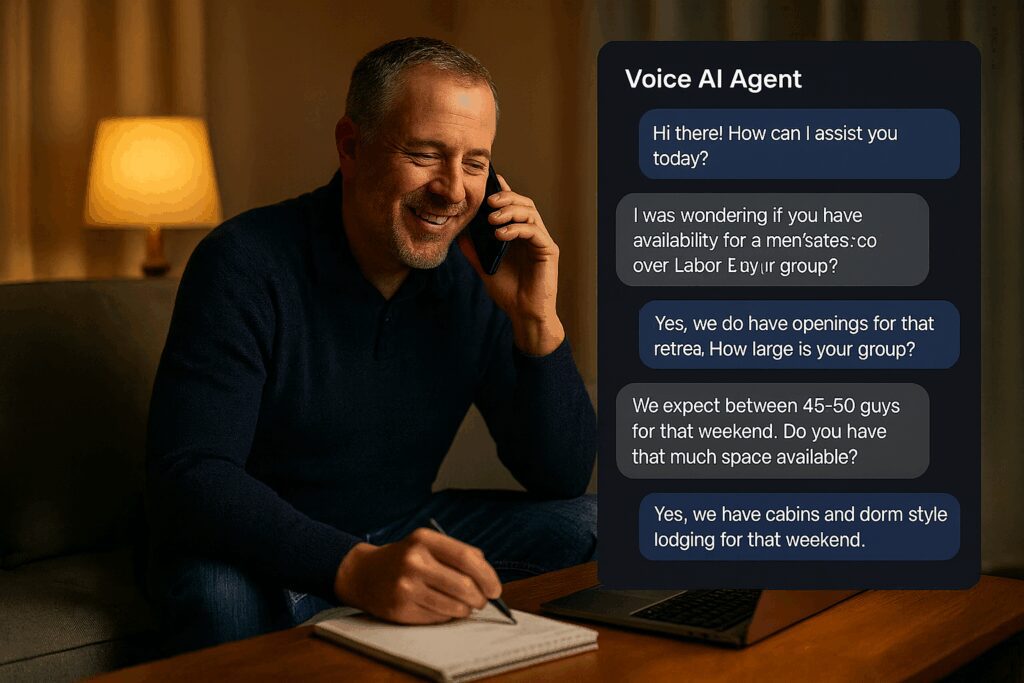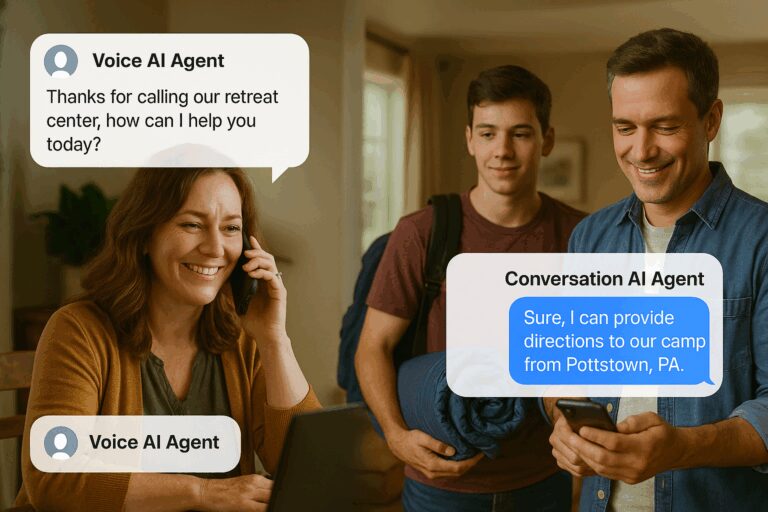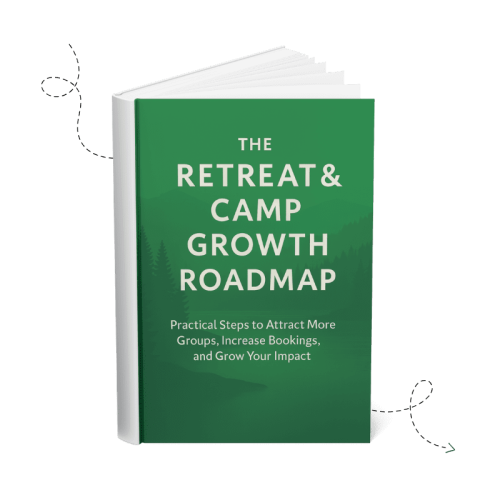Retreat & Camp Growth Roadmap Focus Area: Enhance Inbound Responses
Introduction
Retreat center AI automation is transforming how Christian camps and retreat ministries manage inbound inquiries by helping staff respond faster and more consistently while still preserving a warm, personal connection.
Most retreat and camp leaders can point to one recurring challenge: the flood of incoming questions. As a center grows, so does the volume of inquiries—and not just phone calls. Today, messages arrive through email, web chat, text, Facebook Messenger, Instagram DMs, and sometimes even WhatsApp. What feels like a trickle when your calendar is light can quickly grow into a constant stream.
For smaller retreat centers with only one or two staff handling inquiries, it often means long delays in replies, voicemails piling up over the weekend, and stressed staff trying to keep up. Picture a part-time office manager who already wears six hats—coordinating volunteers, handling paperwork, and answering phones—only to find three missed calls, two Facebook messages, and a couple of website chat requests waiting on Monday morning. By the time she replies, one group has already booked elsewhere.
For larger, more established retreat centers, the challenge looks different but feels just as heavy. Hundreds of inquiries pour in each month, many asking the same five or six questions: “What’s your lodging capacity?” “Do you offer meal service?” “Can you host a men’s retreat in October?” Staff scramble to respond across multiple channels, but with so many moving parts, some inquiries slip through the cracks. A youth leader might send a late-night DM about availability and get no response until the next afternoon—by then, she’s already reserved a different venue.
The result is predictable: missed opportunities. In an era when instant communication is the norm, even a 24-hour delay can feel like silence. A slow response can make the difference between a new booking and a lost lead.
This is where automation and AI step into the conversation. Not as a replacement for the human warmth that defines your ministry, but as a bridge. Thoughtfully set up, AI-powered Voice AI agents for phone calls and Conversation AI agents for chat, text, and social channels can provide immediate, consistent responses, gather information, and even book calls with your team—while always leaving space for human handoff when needed. The key is not letting technology run unchecked, but guiding it with your knowledge, your policies, and your brand voice so it serves as an extension of your team rather than a substitute.
Why This Focus Area Matters
When someone reaches out, their first impression of your center begins at that moment of inquiry. A slow response feels like disinterest. In today’s world, guests are used to nearly instant communication—Amazon updates deliveries by the hour, Airbnb confirms reservations instantly, and churches stream live every Sunday. Those cultural shifts have changed what people expect. Camps and retreat centers are no exception.
For larger centers, scaling staff at the same rate as inquiries isn’t practical. For smaller centers, the opposite is true: they simply don’t have the staff to begin with. AI agents help both ends of the spectrum by stretching the team’s capacity without sacrificing hospitality.
It’s important to be clear about what this is not. These AI agents are not replacements for staff, and they are not “set it and forget it.” Left unchecked, they can frustrate guests instead of serving them. They require thoughtful setup, regular monitoring, and alignment with your brand voice. Done right, though, they help ensure every inquiry receives a timely, helpful response.
Example: One retreat center experimented with a stand-alone chatbot. Because no one was monitoring it, the bot kept giving outdated pricing. Guests became frustrated. They solved the problem by moving to an integrated CRM-based tool, with a monthly review process to keep responses current. Guest trust was restored, and staff saved hours each week.
Is This an Area You Need to Focus on Right Now?
Ask yourself:
- Do staff spend a large portion of their time repeating the same answers?
- Are we missing inquiries because no one is available to respond right away?
- Have prospective guests waited more than 24 hours for a reply?
- Are we juggling disconnected tools for calls, chat, and email?
- Do we need to handle more inquiries without adding new staff?
If you answered “yes” to any of these, this focus area can help you bring greater clarity, alignment, and impact to your outreach.
Putting This Focus Area into Practice
Selecting the Right Technology
Before diving into setup, it’s critical to choose the right tools. The market is flooded with emerging AI platforms—some impressive, some unproven, and many that create more complexity than clarity. A retreat center doesn’t need the latest flashy app; it needs a stable, proven system that integrates smoothly into daily operations.
Here are key considerations:
- Stability and Support: Emerging tools often lack consistent support or long-term stability. Established platforms offer better reliability.
- CRM Integration: The best AI tools are either native to your CRM or tightly integrated with it. This ensures every conversation is logged in guest records and prevents staff from juggling multiple disconnected systems.
- Appropriate Scale: Large enterprise platforms like HubSpot offer sophisticated AI and automation features, but they often come with high costs and complexity more suited to large organizations.
For retreat centers and camps, a more practical option is LeadHub CRM. Built for small to mid-sized organizations, LeadHub combines CRM capabilities with Voice and Conversation AI tools in one place. It’s cost-effective, integrates easily with many camp management systems, and provides the features needed to handle guest communications without overwhelming staff.
By starting with the right platform, you’ll avoid the pitfalls of cobbled-together tools and set your team up for success.
Build Your Knowledge Base
A knowledge base is the foundation that makes AI useful. Without it, the system has nothing to say—or worse, it says the wrong things.
What it is: A collection of your center’s information—website copy, FAQs, policies, facility details, and internal documents—that AI uses to generate responses.
Why it matters: The AI doesn’t “know” your ministry unless you teach it. The better the knowledge base, the more accurate and brand-aligned the responses.
How it works:
- Website Content provides general information (lodging, dining, activities).
- FAQs answer the most common questions consistently.
- Policies (like deposits, cancellations, dietary needs) give the AI confidence in handling specific scenarios.
- Internal Documents (like planning guides) prepare the AI for deeper questions.
The AI uses these inputs as its “script.” When someone calls or messages, the system pulls from this knowledge base to respond in your voice, with your information.
Best Practice: Start small. Train the AI on 10–15 core FAQs, then expand over time. Test answers internally before going live.
Pitfall to avoid: Don’t overload the AI with long, policy-heavy text. Guests don’t want a wall of words. Teach the AI to summarize briefly and link to details when needed.
Example: A camp included their dietary guidelines, so when a parent asked about peanut allergies, the AI gave a consistent and accurate response instead of a vague or incorrect answer.
Configure Voice AI for Phone Calls
Voice AI can be a powerful tool—but only if configured correctly.
Why configuration matters: An untrained Voice AI Agent might sound robotic, cut callers off, or give incomplete answers. Good configuration makes it sound natural and mission-aligned.
Prompts are the key. A prompt is the instruction that guides the AI.
- Bad Prompt: “Answer the phone politely.” (Too vague—leads to bland, unhelpful answers.)
- Good Prompt: “Greet callers warmly as if you are a retreat coordinator at [Center Name]. Collect name, email, and group size on every call. If the caller asks about pricing, give an overview but encourage them to schedule a call with staff for details.”
Principles for effective prompts:
- Be specific: tell the AI exactly how to respond.
- Be consistent: use the same tone instructions across prompts.
- Build for action: don’t just answer; guide the guest to the next step (like scheduling a call).
Example: With good prompting, a Saturday evening caller asking, “Do you host women’s retreats?” hears a warm, informative response, has their details collected, and is scheduled for a Monday follow-up—all without staff intervention.

Set Up Conversation AI for Messaging
Conversation AI Agents work across chat, text, and social channels. Like Voice AI Agents, they live or die by their configuration.
Why configuration matters: Poorly set-up Conversation AI Agents can feel like an impersonal automation barrier. Proper prompting makes them feel human and helpful.
Prompting principles for chat:
- “Always greet guests warmly and by name when possible.”
- “Keep answers brief and friendly—no jargon.”
- “If you don’t know, offer to connect them with staff.”
- “Always end with a call to action—schedule a call, provide contact info, or confirm details.”
Example: A youth leader sends a DM at 10:30 PM asking about lodging capacity. The AI, prompted to “respond warmly and guide toward next steps,” confirms capacity, collects group size, and offers to book a planning call. By Monday, the lead is already in the CRM, ready for staff.

Define Human Handoff Rules
AI Agents should never be a wall between you and your guests. Define when and how they hand conversations back to your staff.
Example: A guest types, “Can I talk to someone directly?” The system immediately offers to transfer the call or schedule a callback. The guest feels valued and not stuck in a loop.
Keep It Integrated, Not Complicated
There are dozens of stand-alone chatbots and call systems on the market. Most add confusion—creating silos where conversations aren’t logged, or staff don’t have full context.
Integrated CRM-based tools keep everything in one place. Every call, chat, or DM is tied to the guest record, making follow-up smoother and preventing details from being lost.
Example: An inquiry about food allergies comes in via chat. Because the tool is integrated with the CRM, the note is automatically attached to the guest’s booking record. Staff preparing meals don’t miss it.
Monitor and Refine Regularly
These tools require oversight. Review transcripts regularly, update FAQs, and adjust prompts to reflect your tone. This ensures the AI stays accurate and aligned with your mission.
Example: A camp director reviewed monthly transcripts and discovered guests asking about a new program that wasn’t in the knowledge base. Updating the AI fixed the gap immediately. We’ve also seen this in our own agency—reviewing call recordings and chat transcripts regularly helps us fine-tune our Voice AI Agent and Conversation AI Agent so they continue to sound natural, stay accurate, and reflect our brand voice.

Pitfalls to Avoid
- Expecting perfection from day one. Even well-configured AI Agents need testing and refinement. We’ve learned this firsthand by running new agents internally first, making adjustments, and only then rolling them out more broadly.
- Neglecting regular monitoring.
- Training AI with outdated or overly complex info.
- Relying on multiple disconnected tools instead of one integrated solution.
- Giving AI too much responsibility too quickly.
- Forgetting to build clear handoff rules for staff.
Thoughtful implementation makes all the difference. Inbound AI strengthens your first impression, ensures guests are acknowledged promptly, and relieves staff from repetitive tasks—all while keeping the human touch in place.
Enhance Inbound Responses Worksheet
📥 Download the Voice & Conversation AI Configuration Planning Worksheet
This worksheet is designed to help you plan your AI setup before turning it on. Inside, you’ll find:
- A template for listing your most common FAQs.
- A guide for writing clear, action-oriented prompts.
- A framework for deciding what AI should handle vs. when staff should step in.
- A monitoring checklist to keep responses current and accurate.
Use it to build confidence in your setup and ensure your Voice and Conversation AI Agents reflect your mission and brand voice.
Mini Case Study
At our agency, we make it a priority to test new tools and approaches before recommending them to our clients. That includes implementing both Voice AI Agents and Conversation AI Agents within our own systems using LeadHub CRM.
We started by building a knowledge base from our website content and FAQs, then trained the AI agents with prompts to guide their responses in our brand voice and tone. We configured the agents to qualify callers, collect contact information, transfer calls, schedule callbacks, and even book meetings when appropriate.
The first iteration wasn’t perfect. As with any new tool, the Voice AI Agent and Conversation AI Agent required fine-tuning and careful testing before they could meet our standards. We quickly learned that prompt wording, handoff rules, and knowledge base clarity all made a significant difference in how natural and accurate the responses felt.
To improve, we adopted a process of regular monitoring. We review call recordings and chat transcripts on an ongoing basis, grading the quality of conversations and updating the knowledge base as needed. Both prospects and existing customers have given feedback—sometimes positive, sometimes critical—and that feedback has been invaluable in shaping how we configure the agents. For example, we’ve adjusted which questions the AI agents handle directly and which ones are better escalated to a human.
The result is a system that is not only more responsive to inbound inquiries but also saves our team time by handling repetitive tasks, filtering out unwanted solicitation calls, and ensuring every legitimate inquiry is acknowledged quickly. This experience has given us confidence in deploying Voice AI Agents and Conversation AI Agents for retreat centers and camps, knowing firsthand the benefits, challenges, and ongoing refinement required to use them effectively.
Putting It All Together
Inbound AI is not a replacement for staff or personal ministry. It’s a way to meet rising guest expectations, handle communication at scale, and serve people well without overwhelming your team.
Key takeaways:
- Identify FAQs and policies that should guide responses.
- Build a strong knowledge base—it’s the foundation of everything.
- Write clear, action-oriented prompts to guide the AI.
- Choose integrated CRM-based tools to avoid silos.
- Start small with one channel (phone or chat) and expand gradually.
- Define clear handoff rules for human support.
- Monitor and refine responses regularly.
Hospitality begins with the first hello. These tools don’t replace your ministry—they ensure no guest inquiry goes unanswered, freeing your team to focus on the conversations that matter most. We know this works because we’ve applied the same approach ourselves—testing, refining, and improving our own Voice AI and Conversation AI Agents before ever recommending them to others.
Ready to Take the Next Step?
Ready to build guest communication systems that meet expectations without overwhelming your staff? Enhancing inbound responses can help you grow sustainably while keeping your mission front and center.
If you found this helpful, here are four great next steps to continue your journey:
🧭 Move to the Next Focus Area: Build Nurture Workflows
Learn how to build automated email and SMS workflows to keep prospects engaged and move them toward booking.
[Read the Build Nurture Workflows Focus Area Article]
📘 Download the Retreat & Camp Growth Roadmap eBook
Get the full 3-stage system we use to help retreat centers and camps grow with clarity and purpose.
[Download the eBook]
🌱 Learn More About How We Help Retreat Centers & Camps
We’re a Christian-owned digital marketing agency that helps retreat centers and camps grow attendance, bookings, and impact through practical strategies rooted in clarity and stewardship.
[See How We Can Help]
🤝 Schedule a Free Discovery Call
Want help applying this to your unique situation? Let’s talk. We’ll explore where you are now, where you want to go, and how to take the next faithful step.
[Book a Discovery Call]
You don’t have to figure this out alone. Let’s build something meaningful—together.
Frequently Asked Questions
1. Isn’t AI too impersonal for ministry?
Not if it’s guided thoughtfully. With a well-built knowledge base, AI can speak in your voice and reflect your mission. Its role is to greet guests consistently, not to replace relational ministry.
2. Do these tools work for smaller centers, or only for large ones?
Both. Large centers use them to scale communications; small centers use them to stretch limited staff capacity. The principle is the same: ensuring no inquiry goes unanswered.
3. How does the AI know what to say?
You train it with your website content, FAQs, policies, and brand tone. The better your input, the more accurate and mission-aligned its responses will be.
4. What if the AI gives a wrong answer?
That’s why monitoring is essential. Regularly review transcripts, update FAQs, and adjust prompts. Over time, accuracy improves, and errors become rare.
5. Won’t this replace my staff?
No. It’s not designed to replace people—it’s designed to handle repetitive tasks so your staff can focus on higher-value conversations and ministry.
6. What if a guest insists on speaking with a human?
You can set clear handoff rules. If someone requests a person, the AI immediately transfers or schedules a callback.
7. Why not just use a free chatbot or call tool?
Standalone tools often create more problems: data silos, poor support, and incomplete records. Integrated CRM-based tools keep everything in one place, making follow-up much smoother.
8. Is guest information collected by AI secure?
Yes, when using reputable platforms that follow data security standards. Always ensure your CRM and communication tools meet privacy and compliance requirements.
9. How much time does it take to set this up?
Setup varies, but most centers can launch with a handful of FAQs in a few weeks. The key is starting small and expanding gradually.
10. Why LeadHub CRM as a solution?
LeadHub combines CRM features with Voice and Conversation AI agents in one platform. This means all your guest interactions are logged, monitored, and supported—avoiding the confusion of juggling multiple disconnected tools.





